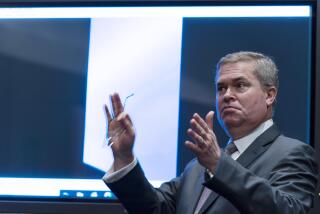In Search of Broad Technological Compatibility
- Share via
WASHINGTON -- Cell phones, remote controls, wireless radios -- can’t they all just get along?
Federal regulators believe so, and they are expected today to launch a sweeping examination of the government’s management of the nation’s valuable airwaves, a move that could pave the way for cheaper and more innovative wireless devices.
At their monthly meeting, members of the Federal Communications Commission are scheduled to consider a highly anticipated report on spectrum management that recommends a more flexible approach to sharing the airwaves, including an overhaul of the standards for governing airwave interference and provisions to allow owners of airwave licenses to resell them under certain circumstances.
Separately, the agency also is expected to authorize the opening up of more airwaves for advanced wireless services.
Although the report is still being fine-tuned and may not be released until later this month, its emergence represents the first significant response to a nearly decade-long push for more flexible use of the airwaves by companies such as Intel Corp. and Microsoft Corp., free-speech advocates and influential thinkers such as Stanford University law professor Lawrence Lessig.
They say the airwaves should be treated like the Internet, an open communications system that nobody owns. They want the nearly 70-year-old system of government regulation of the airwaves modified so that individuals and entrepreneurs would be free to use and trade any spectrum, so long as they did not interfere with other users.
But some powerful wireless industry lobbying groups -- which also are longtime supporters of spectrum reform -- are concerned that the FCC may not pay enough attention to potential interference problems.
“We need to see the specifics,” said Thomas Wheeler, president of the Cellular Telecommunications & Internet Assn. in Washington.
Among other details, Wheeler said the FCC would have to wrestle with how to police interference among rivals trying to gain a competitive advantage. “There needs to be some kind of strong sanction, not just a fine” against users that cause airwave interference, he said.
Proponents of a more flexible approach say deregulation will enable more innovative wireless devices and boost wireless networking technologies such as WiFi and ultra-wide-band, which have helped spur demand for wireless networks for PCs and other machines. Shipments of equipment for wireless networking are expected to balloon from 9 million units in 2001 to about 56 million by 2006, according to the research group Allied Business Intelligence Inc.
Experts believe that with deregulation, WiFi and ultra-wideband could leapfrog the deployment of high-speed Internet access through phone and cable-TV lines, making cheap and ubiquitous broadband access available nationwide by 2006.
University of Pennsylvania professors Gerald R. Faulhaber and David J. Farber say a good way to kick off this new wireless era would be to conduct a one-time “big bang auction” for all the nation’s airwaves and then allow secondary trading of the spectrum.
“Individuals and corporations would be able to buy, sell and lease specific frequencies in specific locations subject to power [and other technical] limitations, and would possess the right to ... [transmit] at anytime without interference,” they wrote in a July filing to the FCC.
FCC Chairman Michael K. Powell didn’t return a call seeking comment. But he signaled last week that spectrum reform will be a cornerstone of his effort to revive the beleaguered telecom industry.
“We should develop policies that avoid interference rules that are barriers to entry,” he said during an address at the University of Colorado in Boulder. “While the proliferation of technology strains the old paradigm, it is also technology that will ultimately free spectrum from its former shackles.”
The campaign has gathered steam in recent months, spurred by industry advances.
A technology called software defined radio, or SDR, was authorized by the FCC last year and is being used to develop intelligent transceivers that can navigate through the congested airwaves without causing electro-magnetic interference.
SDR allows telecom service providers to offer devices that can jump from one communications channel to another as transmission standards change and as unused airwaves become available.
Such flexibility would be especially valuable in the United States, which -- unlike Europe and Asia -- has more than four competing cellular phone standards as well as a host of wireless computer network standards. Engineers envision a day when a cell phone or hand-held computer will automatically reprogram itself to access all of these networks and even act as a TV remote or pager.
“SDR can mitigate the downsides of having multiple wireless transmission standards by making more efficient use of spectrum,” said Vanu Bose, chief executive of Vanu Inc., a Cambridge, Mass., start-up that will demonstrate a software defined radio device later this month in San Diego.
On Capitol Hill, several bills have been introduced to promote airwave reform, including a measure by Rep. Edward J. Markey (D-Mass.) that would more than double the amount of spectrum available for unregulated wireless services such as WiFi.
“Spectrum reform is coming this year one way or another -- whether through legislation or through the FCC,” said Ellen Goodman, an associate professor of law at Rutgers University who has followed the issue.






